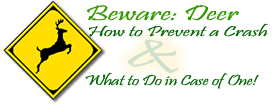|
|

500,000 Auto Colliisons Involve Deer Every Year
It's
early morning and you're beginning the long commute to work. You're going the
speed limit (or maybe just a tiny bit over) and suddenly a deer appears in the
middle of the road. Your heart jumps into your throat. What do you do?
Each
year there are approximately 500,000 deer/auto collisions resulting in over 100
deaths and thousands of injuries. Each deer/auto collision costs the auto insurance
industry about $2,000, according to the Insurance Information Institute.
If a crash with
a deer is unavoidable, the Michigan Deer Crash Coalition (the experts in these
matters) recommends the following steps:
-
Don’t
swerve!
-
Brake
firmly.
-
Hold
on to the steering wheel.
-
Come
to a controlled stop.
-
Pull
well off the road, turn on emergency flashers and be cautious of passing traffic.
-
Do
not attempt to remove a deer from the roadway unless you are convinced it is dead.
An injured deer’s sharp hooves can easily hurt you.
Sometimes
you can prevent what could be a deadly collision. The best course of action is
to drive defensively and follow these tips:
-
Fasten
your safety belts. They are the best protection for yourself and your family in
the event of a crash.
-
Drive
with caution all-year-round in deer habitat, especially on rural two-lane roads.
-
Deer
can dart out from any direction without warning. Deer often travel in single file.
If you see one whitetail cross the road, chances are there are more nearby.
-
Deer
are most active near dawn and dusk, and especially during the fall mating season
and in spring, when they are on the move to find food, often near roads, where
the grass greens up first.
-
Be
especially alert near deer warning signs. They are placed at known deer crossing
areas and alert drivers of the possible presence of whitetail.
|